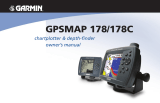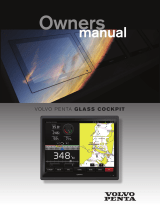
2 GPSMAP
®
4000/5000 Series Owner’s Manual
Table of Contents
Table of Contents
Introduction ������������������������������������������������i
Tips and Shortcuts ���������������������������������������������� i
Manual Conventions ������������������������������������������� i
Getting Started ������������������������������������������1
Front and Back Panels �������������������������������������� 1
Turning On the Chartplotter ������������������������������� 2
Turning Off the Chartplotter ������������������������������� 2
Initial Chartplotter Settings �������������������������������� 2
GPS Satellite Signal Acquisition ������������������������ 2
Adjusting the Backlight �������������������������������������� 2
Adjusting the Color Mode ���������������������������������� 3
Inserting and Removing Data and Memory
Cards �������������������������������������������������������������� 3
Viewing System Information ������������������������������ 3
About the Home Screen ������������������������������������ 4
Charts and 3D Chart Views ���������������������� 5
Navigation Chart ������������������������������������������������ 5
Automatic Identication System ���������������������� 15
Perspective 3D ������������������������������������������������ 19
Radar Overlay ������������������������������������������������� 21
BlueChart g2 Vision ����������������������������������������� 21
Mariner’s Eye 3D ��������������������������������������������� 22
Fish Eye 3D ����������������������������������������������������� 23
Fishing Chart ��������������������������������������������������� 24
Showing Satellite Imagery on the Navigation
Chart ������������������������������������������������������������� 25
Viewing Aerial Photos of Landmarks ���������������26
Animated Tide and Current Indicators ������������� 26
Detailed Road and Point of Interest Data �������� 26
Auto Guidance ������������������������������������������������� 26
Combinations ������������������������������������������27
About the Combinations Screen ���������������������� 27
Combinations Screen Conguration ���������������� 27
Navigation �����������������������������������������������31
Basic Navigation Questions����������������������������� 31
Navigation with a Chartplotter ������������������������� 31
Waypoints �������������������������������������������������������� 32
Routes ������������������������������������������������������������� 33
Tracks �������������������������������������������������������������� 36
Navigating with a Garmin Autopilot������������������ 38
Where To? ����������������������������������������������� 39
Marine Services Destinations �������������������������� 39
Almanac, Environmental, and On-boat
Data ����������������������������������������������������������42
Almanac Data �������������������������������������������������� 42
Environmental Data ����������������������������������������� 44
On-boat Data ��������������������������������������������������� 47
Device Conguration �����������������������������51
Basic Device Conguration Questions ������������ 51
Simulator Mode ����������������������������������������������� 51
Display Conguration �������������������������������������� 52
Navigation Preferences ����������������������������������� 52
Information about Your Boat ���������������������������� 59
Alarms ������������������������������������������������������������� 59
Chartplotter Data Management ����������������������� 60
Networked Device Conguration ��������������������� 62
Radar �������������������������������������������������������63
Transmitting Radar Signals ����������������������������� 63
Stopping the Transmission of Radar Signals��� 63
Adjusting the Zoom Scale on the Radar Screen
���������������������������������������������������������������������� 63
Radar Display Modes �������������������������������������� 64
Radar Targeting ����������������������������������������������� 68
Waypoints and Routes on the Radar Screen �� 72
About the Radar Overlay ��������������������������������� 73
Optimizing the Radar Display �������������������������� 74
Radar Display Appearance ������������������������������ 80
Radar Overlay Display Appearance ���������������� 84
Sonar �������������������������������������������������������87
Sonar Views ���������������������������������������������������� 87
Water Temperature Log ����������������������������������� 88
Waypoints on the Sonar Screen ���������������������� 88
Sonar Screen Settings������������������������������������� 89
Frequencies ����������������������������������������������������� 91
Noise and Interference Settings ���������������������� 92
Sonar Screen Appearance ������������������������������ 92
Sonar Alarms ��������������������������������������������������� 94
Transducer Conguration �������������������������������� 95
Digital Selective Calling ������������������������� 97
Chartplotter and VHF Radio Functionality ������� 97
Turning On DSC ���������������������������������������������� 97
About the DSC List ������������������������������������������ 97
Incoming Distress Calls ����������������������������������� 98
Man-Overboard Distress Calls Initiated from a
VHF Radio ���������������������������������������������������� 98
Man-Overboard Distress Calls Initiated from the
Chartplotter ��������������������������������������������������� 98
Position Tracking ��������������������������������������������� 98
Individual Routine Calls ��������������������������������� 100
Making an Individual Routine Call to an AIS
Target ���������������������������������������������������������� 101
Appendix �����������������������������������������������102
Specications ������������������������������������������������ 102
Calibrating the GPSMAP 5000 Series
Touchscreen ������������������������������������������������ 103
Screenshots��������������������������������������������������� 103
Viewing GPS Satellite Locations ������������������� 103
System Information���������������������������������������� 103
NMEA 0183 and NMEA 2000 ������������������������ 104
Registering Your Device �������������������������������� 107
Contacting Garmin Product Support�������������� 107
Declaration of Conformity ������������������������������ 107
Software License Agreement������������������������� 107
Index ������������������������������������������������������108





















